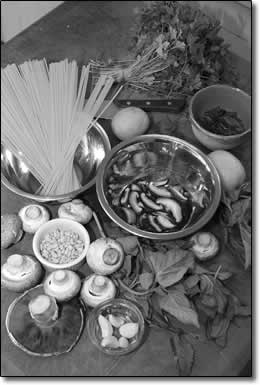|
|
||
|
Fungal safari
by Chef Boy Ari s the moist earth warms toward summertime, the fruiting bodies of various subsurface fungi break above the surface. Known as mushrooms, many of them are edible. Soon, stores will begin stocking fresh oyster mushrooms, porcinis and the crème de la crème of fungal fruiting bodies, the morel. To help you enjoy the fungal pleasures that will soon be ours, I gained access to the home kitchen of Chef Ray Risho. He agreed to show me how to make one of his fungal favorites. “Linguini con Funghi e Formaggio,” which means linguini with mushrooms and cheese, is the most popular dish at Perugia, Ray’s restaurant. While his recipe quantities are geared for serving scores of guests, Ray made a good-faith attempt to translate his recipe to a smaller scale. This meant getting a little technical. “To make a quantity that feeds two people,” he said, “we want 3 cups of cooked pasta. A pound of dry linguini makes 8 cups. So to end up with 3 cups, use 3/8 pound.” Ray pulled his kitchen scale from the cabinet. “This is not really a laboratory dish, but a lot of people these days want laboratory specifications,” he said, winking as he weighed out 3/8 pound of linguini, “they want to be kitchen technicians.” For nontechnicians, this is a thick-but-not-enormous handful of linguini. Ray heated two quarts of water, with 1/8 cup of salt, adding the pasta when it boiled. While it cooked, Ray chopped fresh basil, oregano and parsley until he had ¾ cup, lightly packed. He grated 1/3 cup of parmesan and romano cheese. He mashed five cloves of garlic. He sliced 2 cups of mushrooms: white button, crimini, portobello, morel, oyster and shitake. If you don’t have every one of these different mushrooms, don’t worry. I’ll be in Alaska this summer on morel safari, and you can bet I’ll be cooking up a camp version of “Linguini con Funghi e Formaggio” with nothing but morels. When the linguini was al dente (with just a receding sliver of dry, white center), Ray used a pasta claw to scoop the noodles from the boiling water into a dish, where he tossed them generously in 3 tablespoons olive oil, and set them aside. In a large wok (or skillet), Ray combined 1 tablespoon butter and 2 tablespoons olive oil on medium heat. He added 1/3 cup of pine nuts and the mashed garlic, toss ing the nuts just until they started to brown. “A common mistake many cooks make,” says Ray, “is over-browning the nuts.” When they began to turn color, he added the mushrooms, tossing, tossing. Season with ¼ teaspoon fresh ground pepper and “a kiss of salt.” When the fungus started to brown, he tossed in the herbs, then the pasta, then the juice of half a juicy lemon. “Careful,” he cautioned, “lemon seeds look like pine nuts.” After tossing in ¼ cup of the grated cheese, Ray found the mixture “a little dry.” So he scooped 3 or 4 tablespoons of the starchy pasta water into the pasta, adding moisture and body. Then he transferred the fragrant mixture onto a large plate, garnishing with a handful of pomegranate seeds and the rest of the grated cheese. He squeezed a quarter lemon over the loaded plate and placed the remaining quarter lemon on top. “Voila.” “The red of the pomegranate, the green of the herbs and the white of the cheese reflect the colors of the Italian flag,” Ray pointed out as we sat down to eat. Ray is a master of using pomegranate seeds to unlock flavor. They add a tart kick that cuts through fat like fireworks in your mouth, not unlike a sip of wine. I savored the flavors as Ray discussed the theory involved. “The fat carries the flavor. This flavor is a traditional Mediterranean, which is a combination of sweet, sour, bitter and salt. Basil and pine nuts: sweet. Lemon and pomegranate: sour. Garlic and parsley: bitter. Cheese and salt: salt.” Be forewarned, pomegranates are hard to find this time of year. If you have to skip them (there is no substitute), it’s OK, because the lemons carry the sour load just fine. As for the morels … they might be a bit more expensive than last year. Morels are most prolific in the first year after a forest fire, and last year the fires were slim. This is good for the lungs of the West, bad for epicureans around the world – especially French and Japanese – who look forward to the western U.S. morel harvest. The one hope for a bountiful morel harvest lies in Alaska, where 6.5 million acres burned last summer. Hence, my aforementioned morel safari. Alaska, legendary land of treasure, where the promise of riches lures prospectors from far and wide to try their luck. Alaska, rough-and-ready gambler’s paradise, where the odds are good, but the goods are odd. Chef Boy Ari is gonna go for it, riding shotgun up the Al-Can Highway with mycologist Dr. Larry Evans, one of the world’s experts on finding fungus. •
|


